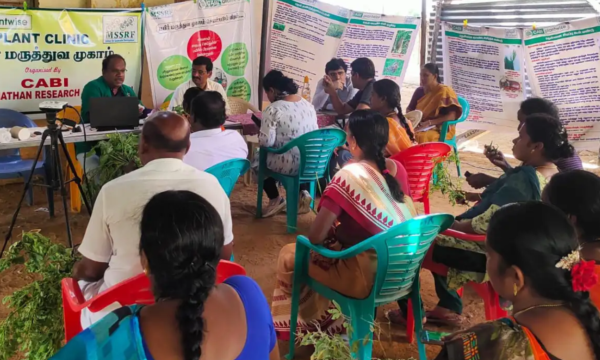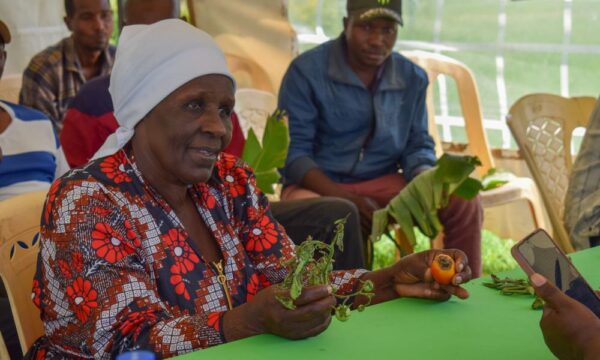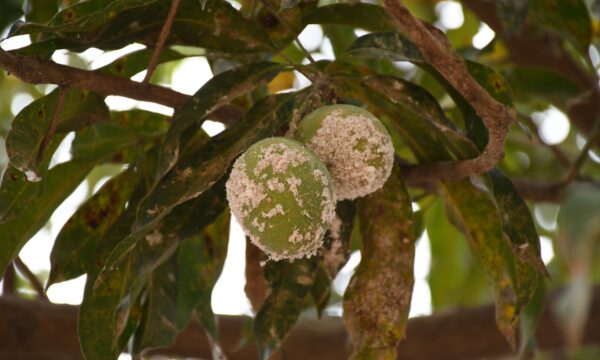This article was originally published on ‘the better india’

When K Pathi noticed the notorious Fall ArmyWorm attack his corn plants, he didn’t rush to get pesticides. He did something entirely different.
When 49-year-old K Pathi, a farmer in Maramadakki village in Pudukkottai district of Tamil Nadu, noticed the notorious Fall ArmyWorm (locally known as the ‘American Padai Puzhu’) attack his corn plants, he didn’t rush to get pesticides over-the-counter. Although many farmers would have done this, he did something entirely different.
He pulled out his cell phone and shot a few pictures of the worm-infested plants.
Next, he rang up Dr P Senthil Kumar, the friendly ‘plant doctor’ of M S Swaminathan Research Foundation (MSSRF) stationed in Pudukkottai town. He shared images of the affected plants, described the pest, and the condition of his plants.
Pathi tried the remedy prescribed by Dr Senthil Kumar. But the worms continued to hold on his crops. Undaunted, Pathi reported it, and a different treatment was prescribed.
Eventually, Pathi managed to save 80 per cent of his corn crop. He says, “I have been growing corn for the last 10-12 years. It is only in the last two years that my crop has been getting infested by the American padai puzhu.”
The lockdown had cut off villages like Maramadakki. Nevertheless, the farmers here, and other villages in Tamil Nadu, Odisha, Assam, and Puducherry have been getting their crop woes addressed.
Courtesy e-plant clinics.

Be it saving their brinjal crops from the devastating shoot and fruit borer worm (Leucinodes orbonalis), or protecting jasmine buds from budworms (Hendecasis duplifascialis) that feed on precious jasmine petals, or other pests that wreak havoc on crops, these farmers are getting it all treated remotely.
One would have expected telemedicine to have caught on with tech-savvy city dwellers first, but it looks like villagers have taken the lead! For many farmers in villages like Maramadakki, telemedicine – for crops – is now an accepted and necessary way of life!
In fact, these farmers regularly attend online plant clinic sessions – webinars – to keep track of the pests reported by fellow farmers in the region and learn about preventive measures. Thanks to the lockdown, they have become very much at ease in going on camera, using webinar tools like ‘chat’, ‘mute’, and ‘zoom’ effectively; shooting pictures, videos and sharing screens; and connecting virtually with plant doctors hundreds of kilometres away.
The plant clinics began as offline events in 2012. They were an initiative of MSSRF, in partnership with the UK based non-profit, Centre for Agriculture and Bioscience International (CABI). The sessions aimed to solve plant and soil woes judiciously, share best practices, bring down the costs of cultivation, inform farmers about market rates and help them plan their next crops in the villages of Tamil Nadu, Assam, Odisha, and Puducherry.
A village would be chosen as a nodal centre for the plant clinic, and farmers from six neighbouring villages/hamlets would attend. For instance, in the Pudukkottai district, plant clinics were conducted in the villages of Neduvasal, Maramadakki, and Vadakadu.

Since 2012, thirty such clinics covering 175 hamlets or villages have been operational. These sessions soon shifted to the virtual since the lockdown.
“Before the lockdown, 2,141 plant clinic sessions were held, engaging 34,217 farmers who brought in 34,876 crop samples,” informs MSSRF’s Dr R Rajkumar. He’s the coordinator of the Plant Clinic Project.
The COVID-19 lockdown forced plant clinics to evolve, as several farmers were calling in with queries. Meanwhile, a young farmer suggested they go online, and e-plant clinics began.
GoToMeeting is the app used, and about 160 farmers can log on to the virtual meeting at a time. “Usually around 65 farmers participate,” informs ‘plant doctor’ Dr P Senthil Kumar. He is also Advisor – Agri, MSSRF.
Through voice and text messages, farmers are informed of the sessions in advance. “We also send them the link so that they can log on to the meeting easily,” says Dr Rajkumar.

Farmers have made the transition to virtual meetings quite well. “Communication has been smooth, through the chat and image-sharing options of the app. Farmers describe and show the affected plants, and we look at the affected plant through the close-up option to ascertain the nature and progress of the disease. We give the remedy through the chat option and also send out the same by SMS,” Dr P Senthil Kumar shares.
He adds that online observation is as good as direct observation, and “coupled with our experience of the issues in these villages, the consultations work out very well”.
Those selected to be plant doctors, like Dr Senthil Kumar, undergo training by the MSSRF and CABI on emerging diseases, control methods, green control methods, etc.
During the lockdown, the plant doctors were given virtual updates on the same. As of now, 32 such plant doctors are on the job in this initiative, tending to 548 farmers from Tamil Nadu and Puducherry, and 140 farmers from Assam and Odisha, during the lockdown.
“If the disease is at the nascent stage, then we advise farmers to use mechanical methods – remove and destroy the affected plant parts. If around 7-10 percent of the crops are affected, we recommend bio-agents – laboratory created, or potent indigenous botanicals from the extracts of local plants and trees – neem, adathoda, nochi (vitex), pungan, erukku (calotropis), karuvel (prosopis), etc. If around 15-20 percent of the crops have been infested by pests, or if bio-agents are not available, we prescribe yellow- and green-labelled plant protection chemicals approved by the World Health Organization. The red-labeled ones are not recommended as they are considered to be too toxic,” Dr Senthil Kumar explains.

After these consultations, there are follow-ups. “On the third day, we call the farmers to check the progress, and then again on the seventh and 30th days. By then, we usually find that the menace has been controlled.”
Jayashree Balasubramanian, Director – Communication and Stakeholder Engagement, MSSRF, elaborates, “When farmers resort to unguided pesticide use, they end up using a higher quantity than required, or an unsuitable one altogether. Not only is this harmful, but it also hikes up production costs and thereby cuts down their profits and makes them vulnerable to debt cycles.”
The pest problem is no small issue for farmers. As per the United Nations’ Food and Agriculture Organization, up to 25 per cent of annual production loss in India in 2015 was due to disease and pests. In this regard, timely diagnosis of pest, disease, and nutritional deficiencies hampering crop growth is necessary for minimising production losses, along with judicious usage of pesticides.
“It is to address such issues that we started the plant clinics,” says Jayashree Balasubramanian. She voices, “MSSRF hopes to increase use of technologies, especially at times where physical activity is restricted. We are also advocating with government officials so this can be scaled up to different states.”
Well, gauging from how well farmers adapted to telemedicine for their crops, it looks like e-plant clinics are here to stay.
Helplines for availing plant clinic services are:
7299935543 and 9942211044 for Tamil Nadu and Puducherry,
9078999668 and 9937263687 for Odisha,
and 6003146232 and 6026035966 for Assam.
Images courtesy: M.S. Swaminathan Research Foundation (MSSRF)
1 Comment
Leave a Reply
Related News & Blogs
Horizon scanning for climate-driven pest threats can prevent biodiversity loss
On International Day for Biological Diversity, CABI’s Dr MaryLucy Oronje looks at horizon scanning and pest preparedness – approaches that help prevent the spread of invasive species, a major threat to biodiversity. Horizon scanning for invasive pests…
22 May 2025





This is amazing we will try to emulate this in Kenya ,with a few Plant Doctors and farmers.
Benson Masinde
Plant Clinics Coordinator
Bungoma County
Kenya